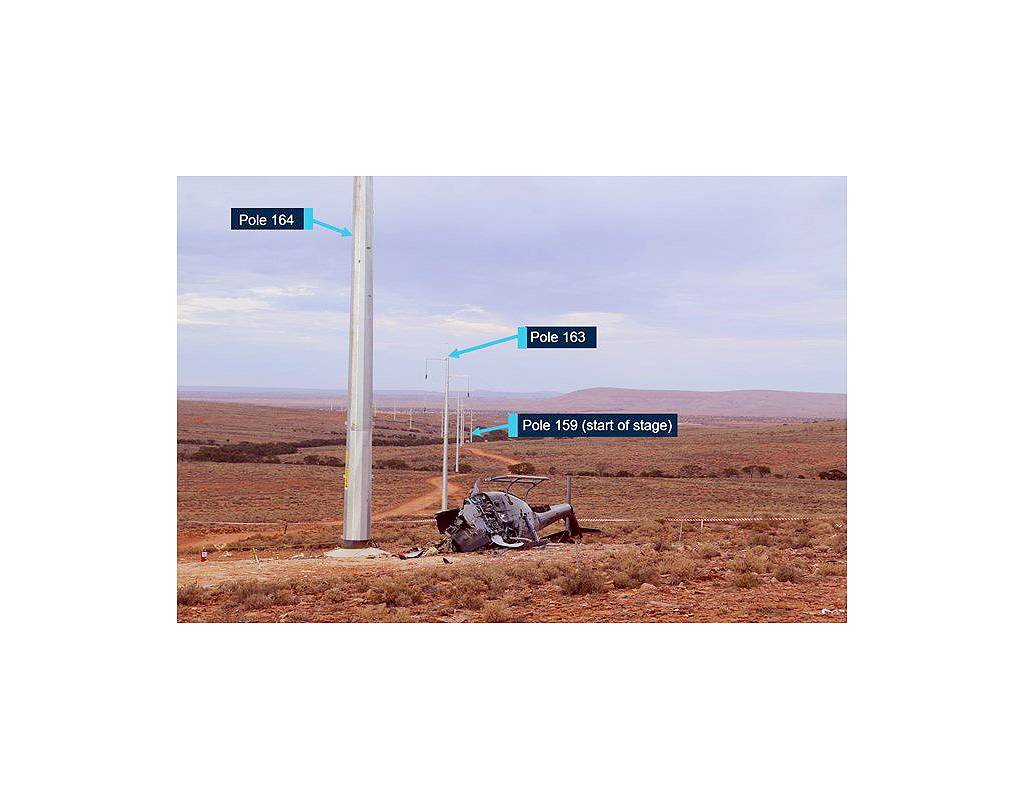
An Australian Transport Safety Bureau (ATSB) investigation into an accident where a Squirrel helicopter struck a powerline pole identified that the operator’s procedures had no requirements to provide any post-training supervision for powerline operations, and that what supervision was provided was ineffective in identifying that the pilot was using a modified stringing method.
The AS350B3e Squirrel helicopter, registered VH-SZS and operated by Aeropower, was stringing powerlines from the Mount Gunson South substation to the Carrapateena mine site, a total distance of 51 kilometers, approximately 60 kilometers east of Woomera Airfield, South Australia on 20 March 2019.
While pulling the draw wire with a nose-high and rearward attitude, the helicopter’s main rotor blades struck the pole about 17 meters above the ground. The helicopter subsequently impacted the ground near the base of the pole.
Several ground crew from the stringing team extinguished a small post-impact fire and removed the pilot from the aircraft to a safe distance. A short time later emergency services and paramedics from the mine site attended the scene and confirmed that the pilot, who was the sole occupant, had received fatal injuries. The helicopter was destroyed.
Shortly after being trained in powerline stringing operations, for unknown reasons, the pilot modified the stringing methodology. In addition to placing the helicopter at low level in the vicinity of the powerline poles, the modified methodology also exacerbated the uptake of dust. This, in combination with the position of the sun and the rearward attitude of the helicopter, likely reduced the pilots’ visibility of the pole and their situational awareness of it.
“There were no requirements in the operator’s procedures to provide any post-training supervision for powerline operations,” Director Transport Safety Stuart Macleod said.
“What supervision was provided was ineffective in identifying that a modified stringing method was being used by the pilot.”
In November 2020, the ATSB were advised that Aeropower had taken a number of proactive safety actions specifically relating to the supervision and review of newly authorized pilots in specialist tasks.
“These actions taken by Aeropower address the key concern of the investigation’s identified Safety Issue, being the supervision of pilots recently trained or authorized in a new specialist task,” Mr. Macleod said.
“The mandated extension of command under supervision time, the introduction of periodic consolidation flight checks, and the mandated extension of mentoring time are all expected help better prepare newly trained pilots for solo operations and provide them with additional defenses to the hazards associated with specialist flight tasks.”
The investigation also highlighted that experience alone will not always prevent a pilot from having an accident. In this case, the pilot was a very experienced deputy chief pilot with nearly 6,500 flight hours.
Research published by the ATSB in 2012 as part of its Avoidable Accidents series titled Experience won’t always save you, showed experience does not always provide a safeguard.
“Using pilot experience as mitigation for potential operational risks is inadvisable,” Mr. Macleod said.
“The ATSB has found that in some occurrences very experienced pilots were undertaking flying that involved much higher risk. And as a consequence, we found that in those circumstances their flying experience alone was unable to help them avoid an accident.”
Read the final report AO-2019-015: Collision with terrain involving Airbus Helicopters AS350B3e, VH-SZS 60 km east of Woomera Airfield, South Australia, on 20 March 2019.
This press release was prepared and distributed by the Australian Transport Safety Bureau.



